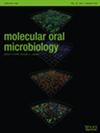唾液链球菌通过代谢产酸抑制黑色素前驱菌的生长,从而改善对上皮屏障的破坏作用
IF 2.9
3区 医学
Q1 DENTISTRY, ORAL SURGERY & MEDICINE
引用次数: 0
摘要
背景口腔扁平苔藓(OLP)是最常见的口腔黏膜疾病之一,女性发病率高于男性,但其发病机制仍不清楚。目前的研究表明,微生物菌群失调可能在 OLP 的发病机制中扮演重要角色。我们之前的研究发现,黑色素前驱菌的增加和唾液链球菌的减少被认为是 OLP 的潜在致病因素。因此,本研究的目的是探讨唾液链球菌能否抵消黑色素前驱菌对上皮屏障功能完整性的不利影响。用唾液腺球菌(MOI = 20)或无细胞上清液预处理 HaCaT 细胞 3 h,然后用黑色素原杆菌(MOI = 5)处理 HaCaT 细胞 3 h。实时定量聚合酶链反应(PCR)检测了紧密连接蛋白的 mRNA 水平。免疫荧光和 Western Blot 用于检测Zonula occludin-1 (ZO-1)的蛋白表达。结果黑色素原虫的挑战降低了 HaCaT 细胞中紧密连接蛋白的水平,包括闭锁蛋白、ZO-1 和 claudin。唾液酸酵母菌或其无细胞上清液抑制了黑色素原虫诱导的 ZO-1 mRNA 和蛋白表达水平的下调,从而改善了上皮屏障功能。结论:这些结果表明,活唾液酸菌或其无细胞上清液能显著改善黑色素原虫对上皮紧密连接的破坏,可能是通过代谢酸的产生抑制了黑色素原虫的生长。本文章由计算机程序翻译,如有差异,请以英文原文为准。
Streptococcus salivarius ameliorates the destructive effect on the epithelial barrier by inhibiting the growth of Prevotella melaninogenica via metabolic acid production
BackgroundOral lichen planus (OLP) is one of the most common oral mucosal diseases, exhibiting a higher prevalence in women than men, but its pathogenesis is still unclear. Current research suggests that microbial dysbiosis may play an important role in the pathogenesis of OLP. Our previous research has found that the increase of Prevotella melaninogenica and decrease of Streptococcus salivarius have been identified as a potential pathogenic factor in OLP. Consequently, the objective of this study is to examine whether S. salivarius can counteract the detrimental effects of P. melaninogenica on the integrity of the epithelial barrier function.Materials and methodsEpithelial barrier disruption was induced by P. melaninogenica in human keratinocytes (HaCaT cells). HaCaT cells were pretreated with S. salivarius (MOI = 20) or cell‐free supernatant for 3 h, followed by treatment with P. melaninogenica (MOI = 5) for 3 h. The epithelial barrier integrity of HaCaT cells was detected by FD4 permeability. The mRNA level of tight junction protein was detected by quantitative real‐time polymerase chain reaction (PCR). Immunofluorescence and Western Blot were used to detect the protein expression of zonula occludin‐1 (ZO‐1). The serial dilution‐spotting assay was applied to monitor the viability of P. melaninogenica at the end of 8 and 24 h incubation.ResultsChallenge by P. melaninogenica decreased the levels of tight junction proteins, including occludin, ZO‐1, and claudin in HaCaT cells. S. salivarius or its cell‐free supernatant inhibited the down‐regulation of ZO‐1 mRNA and protein expression levels induced by P. melaninogenica and thus improved the epithelial barrier function. The inhibitory effect of the cell‐free supernatant of S. salivarius on the growth of P. melaninogenica is associated with metabolic acid production rather than with bacteriocins and hydrogen peroxide.ConclusionsThese results suggest that live S. salivarius or its cell‐free supernatant significantly ameliorated the disruption of epithelial tight junctions induced by P. melaninogenica , likely through the inhibition of P. melaninogenica growth mediated by metabolic acid production.
求助全文
通过发布文献求助,成功后即可免费获取论文全文。
去求助
来源期刊

Molecular Oral Microbiology
DENTISTRY, ORAL SURGERY & MEDICINE-MICROBIOLOGY
CiteScore
6.50
自引率
5.40%
发文量
46
审稿时长
>12 weeks
期刊介绍:
Molecular Oral Microbiology publishes high quality research papers and reviews on fundamental or applied molecular studies of microorganisms of the oral cavity and respiratory tract, host-microbe interactions, cellular microbiology, molecular ecology, and immunological studies of oral and respiratory tract infections.
Papers describing work in virology, or in immunology unrelated to microbial colonization or infection, will not be acceptable. Studies of the prevalence of organisms or of antimicrobials agents also are not within the scope of the journal.
The journal does not publish Short Communications or Letters to the Editor.
Molecular Oral Microbiology is published bimonthly.
 求助内容:
求助内容: 应助结果提醒方式:
应助结果提醒方式:


